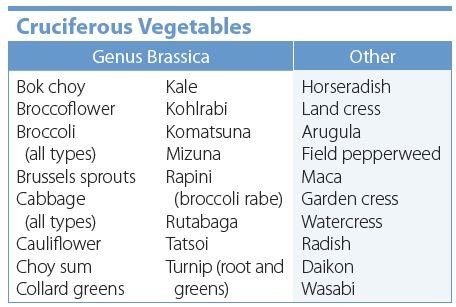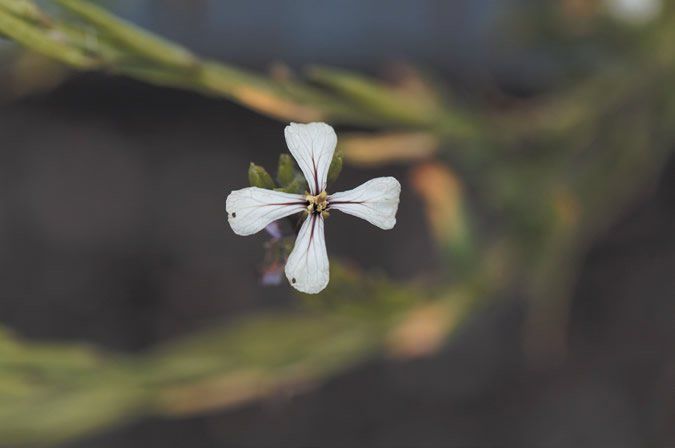You may be surprised to learn that kale and broccoli are cousins. They are part of the Brassica family, also known as cruciferous vegetables because their flower petals form the shape of a cross (cruciferae is Latin for “cross-bearing”). Many other popular vegetables come from this family as well, including Brussels sprouts, cabbage, cauliflower, and collard greens (see “Cruciferous Vegetables” below).
Crucifers, like most other vegetables, are rich in fiber and various vitamins, minerals, and phytochemicals that help preserve and promote human health. “Cruciferous vegetables are also a uniquely rich source of glucosinolates [glu-co-SIN-o-lates],” says Helen Rasmussen, PhD, RD, a senior research dietitian at Tufts’ Jean Mayer USDA Human Nutrition Research Center on Aging and an instructor at the Friedman School. “These sulfur-containing compounds are responsible for not only the (sometimes objectionable) pungent smell and assertive taste of these vegetables, but also for some unique potential healthful qualities.”

Health: Cruciferous vegetables contain a variety of glucosinolates, each of which forms a different compound when broken down. It is these compounds (metabolites) that may be active in our bodies. Although human studies are limited, cell and animal models suggest these metabolites may trigger antioxidant and anti-inflammatory responses that contribute to maintaining healthy cell function. The metabolite sulforaphane, for example, has been shown to trigger antioxidant activity in cell culture. In a mouse model of type 2 diabetes, sulforaphane reduced oxidative damage to the lining of veins and arteries, meaning it has the potential to reduce cardiovascular disease risk.
While there is as yet no proof of cause-and-effect in humans, high intake of cruciferous vegetables is associated with lower risk of bladder, breast, colorectal, endometrial, gastric, lung, ovarian, pancreatic, prostate, and renal cancers. One small trial in humans suggests these compounds may help the body excrete cancer-causing compounds that have entered the body from environmental exposure. There is not enough data to rule out the possibility that people who eat more cruciferous vegetables consume a higher quality diet overall, which could account for some of the positive health associations.
Cooking: The preparation of cruciferous vegetables may affect the levels of glucosinolate metabolites. Chopping (and of course chewing) raw cruciferous vegetables breaks open the plant cells, allowing the glucosinolates to mix with an enzyme that converts them into metabolites. Boiling reduces glucosinolate levels and also inactivates the enzyme, preventing breakdown. Fortunately, gut microbes are able to break down some of the intact glucosinolates that come their way, even in cooked veggies. A recent Dutch study found that stir frying Chinese cabbage prevented loss of glucosinolates. “Although stir-frying, steaming, and microwaving are preferred ways to preserve the glucosinolates in cruciferous vegetables, if cabbage or greens only appeal to you when they’re boiled, you will still get some benefit,” says Rasmussen. “Many people who find the bitterness or sulfur-tinged smell of vegetables like Brussels sprouts, broccoli, or cauliflower off-putting find that roasting them brings out a pleasant sweetness.”
Whether you eat them raw with dip or chopped into in a salad, or cooked as a side or part of a mixed dish, the important thing is to find preparation methods that make these health-promoting vegetables appealing to you.

Try these tips to get the most from your cruciferous vegetables:
-Find ways to enjoy them both raw and cooked
-Aim for 1½ to 2½ cup-equivalents of dark-green veggies per week, including crucifers
-Chop before cooking to release the enzymes that break down glucosinolates into active metabolites
-Stir-fry, steam, or microwave, as opposed to boiling
-Try roasting/baking broccoli, cauliflower, and Brussels sprouts (with a little oil and seasoning) if you’re not typically fond of the taste

























That’s Great Information! Thanks
During my childhood years I used to chew off bites of the cabbages growing in my mother’s garden! I pretended I was one of our rabbits who had escaped his cage, and did the same thing! Perhaps my early love of green cabbage helped me to stave off the elements which cause cancer. I am waiting for news from researchers telling that eating cruciferous veggies is a wise move, wiser than is proven at this point. You might add this idea to any recipes you give out. When making a tossed salad I add thin slices of red cabbage. It adds enticing color,, and allure to the salad.
Very helpful info. !!!!!!!!!!
What about in frozen form?